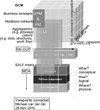1. Huff SM, Rocha RA, Coyle JF, Narus SP. Integrating detailed clinical models into application development tools. Stud Health Technol Inform. 2004. 107:1058–1062.
2. Parker CG, Rocha RA, Campbell JR, Tu SW, Huff SM. Detailed clinical models for sharable, executable guidelines. Stud Health Technol Inform. 2004. 107:145–148.
3. Goossen W. Model once, use multiple times: reusing HL7 domain models from one domain to the other. Stud Health Technol Inform. 2004. 107:366–370.
4. Goossen WT. De Clercq, De Moor G, Bellon J, Foulon M, van der Lei J, editors. Using detailed clinical models to bridge the gap between clinicians and HIT. Collaborative patient centred ehealth. 2008. Amsterdam: IOS Press;3–10.
5. Clinical Data Interchange Standards Consortium [Internet]. Clinical Data Interchange Standards Consortium. c2010. cited at 2010 Nov 20. Round Rock (TX): Clinical Data Interchange Standards Consortium;Available from:
http://www.cdisc.org/site/index.php.
6. SNOMED CT [Internet]. International Health Terminology Standards Development Organisation. c2010. cited at 2010 Nov 20. Cophenhagen: International Health Terminology Standards Development Organisation;Available from:
http://www.ihtsdo.org.
7. European Committee for Standardization (CEN). ISO/CEN 13972 health informatics: quality criteria and methodology for detailed clinical models draft materials. 2010. Brussels: European Committee for Standardization.
8. Open source healthcare solutions that facilitate collaboration [Internet]. The Tolven Institute. c2009. cited at 2010 Nov 20. The Tolven Institute;Available from:
http://www.tolven.org/index.html.
9. Hoy D, Hardiker NR, McNicoll IT, Westwell P. A feasibility study on clinical templates for the National Health Service in Scotland. Stud Health Technol Inform. 2007. 129:770–774.
10. Normative edition of the HL7 Standards 2010 [Internet]. Health Level 7. c2010. cited at 2010 Nov 21. Ann Arbor (MI): Health Level Seven International;Available from:
http://www.hl7.org.
11. van der Kooij J, Goossen WT, Goossen-Baremans AT, Plaisier N. Evaluation of documents that integrate knowledge, terminology and information models. Stud Health Technol Inform. 2006. 122:519–522.
13. European Committee for Standardization (CEN). ISO/CEN 13606: health Informatics-electronic health record communication. 2010. Brussels: European Committee for Standardization.
14. Rector AL, Nowlan WA, Kay S, Goble CA, Howkins TJ. A framework for modelling the electronic medical record. Methods Inf Med. 1993. 32:109–119.

15. Johnson SB. Generic data modeling for clinical repositories. J Am Med Inform Assoc. 1996. 3:328–339.

17. Beale T. Archetypes and the EHR. Stud Health Technol Inform. 2003. 96:238–244.
18. OpenEHR: clinical knowledge manager. Ocean Informatics. c2007-2010. cited at 2010 Oct 20. New South Wales: Ocean Informatics;Available from:
http://www.openehr.org/knowledge/.
19. White TM, Hauan MJ. Extending the LOINC conceptual schema to support standardized assessment instruments. J Am Med Inform Assoc. 2002. 9:586–599.

20. Blobel B. Architectural approach to eHealth for enabling paradigm changes in health. Methods Inf Med. 2010. 49:123–134.

22. Sharfarman M, Gilliam B. Standardizing clinical concept representation: a discussion paper. 2010. Toronto: Canada Health Inforway.
23. Huff SM. Presentation on detailed clinical models. 2010. Utrecht: HL7 Netherlands.
25. de Bel E. Ontwikkeling van een elektronisch patientendossier op basis van HL7. HL7 Mag. 2005. 25:6–8.
26. Goossen WT, Goossen-Baremans A. Bridging the HL7 template: 13606 archetype gap with detailed clinical models. Stud Health Technol Inform. 2010. 160:932–936.
27. Dutch Mirror Group on Information Models & Messages. Insight into the choices to be made in standards for the electronic exchange of health record information. 2008. Delft: Netherlands Normalization Institute (NEN).
28. Blobel B. Advanced and secure architectural EHR approaches. Int J Med Inform. 2006. 75:185–190.

29. Bointner K, Duftschmid G. HL7 template model and EN/ISO 13606 archetype object model: a comparison. Stud Health Technol Inform. 2009. 150:249.
30. Sato L. A NHS logical health record architecture: vision, objectives and success criteria. Technical report. 2008. West Yorkshire: National Health Service.
31. International Organization for Standardization. ISO/FDIS 18308: health informatics - requirements for an electronic health record architecture. 2008. Geneva: International Organization for Standardization.
32. Health Level 7. Electronic health record systems functional model (HL7 EHR-S FM). 2010. Ann Arbor (MI): Health Level Seven International.
33. Cuggia M, Bayat S, Rossille D, Poulain P, Pladys P, Robert H, Duvauferrier R. Comparing the APGAR score representation in HL7 and OpenEHR formalisms. Stud Health Technol Inform. 2009. 150:250–254.
34. Schadow G, McDonald CJ. The unified code for units of measure [Internet]. c1999-2010. cited at 2010 Oct 12. Indianapolis (IN): The UCLM Organization;Available from:
http://unitsofmeasure.org/.
35. Logical observation identifiers names and codes (LOINC) [Internet]. Regenstrief Institute. c1994-2010. cited at 2010 Nov 20. Available from:
http://loinc.org/.
36. International Organization for Standardization. ISO/IEC 10746. ITU-T X.901: reference model for open distributed processing. 1998. Geneva: International Organization for Standardization.
37. OMG model driven architecture: how systems will be built [Internet]. Object Management Group. c1997-2010. cited at 2010 Nov 20. Needham (MA): Object Management Group;Available from:
www.omg.org/mda.
38. van der Zel M, Goossen W. Bridging the gap between software developers and healthcare professionals: model driven application development. Hosp Inf Technol Eur. 2009. 3:20–22.
40. International Organization for Standardization. ISO/FDIS 21090: health informatics - harmonized data types for information interchange. Geneva: International Organization for Standardization.
41. Madden R, Sykes C, Ustun T. World Health Organization family of international classifications: definition, scope and purpose. 2007. Geneva: World Health Organization.
42. International Electrotechnical Commission. ISO/IEC 11179: information technology - Metadata registries (MDR). 2005. Geneva: International Electrotechnical Commission.
43. European Committee for Standardization (CEN). CEN/TS 15699:2009 - health informatics-clinical knowledge resources-metadata. 2009. Brussels: European Committee for Standardization.





 PDF
PDF ePub
ePub Citation
Citation Print
Print








 XML Download
XML Download